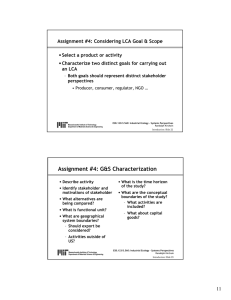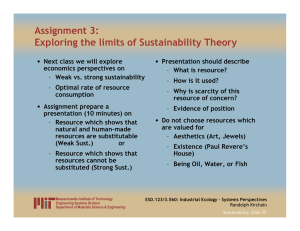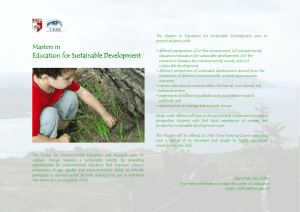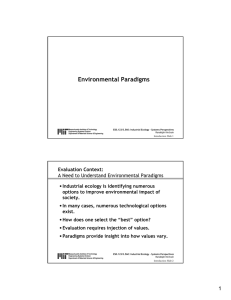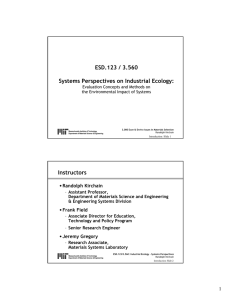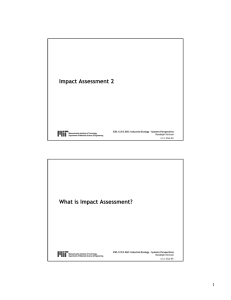Document 13552006
advertisement
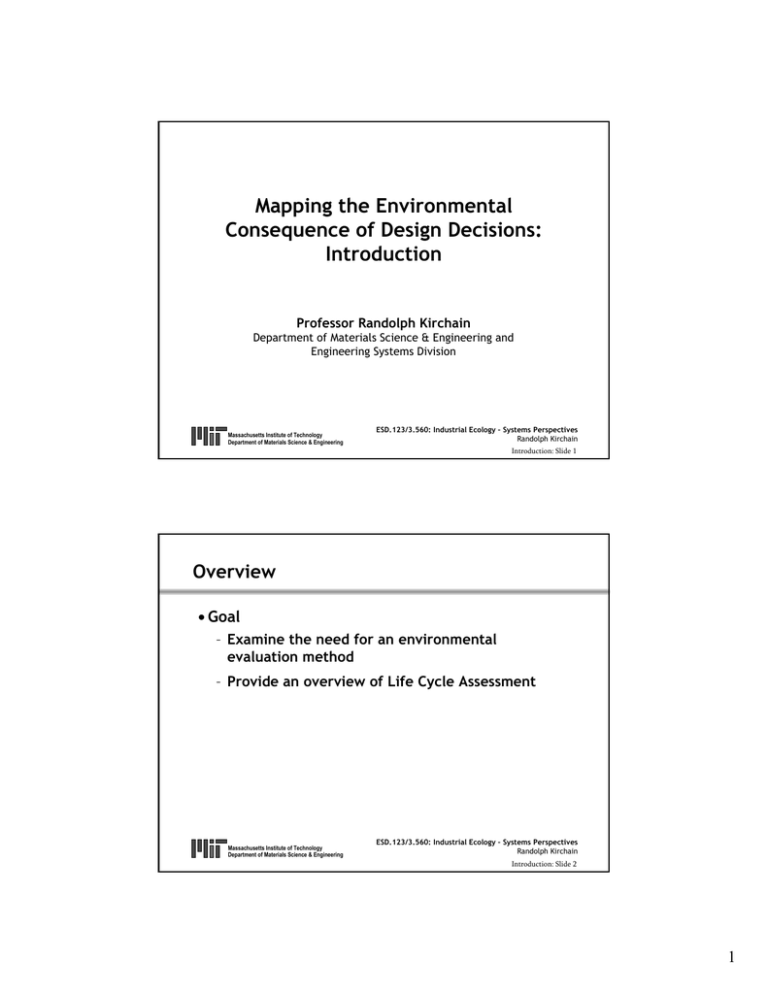
Mapping the Environmental Consequence of Design Decisions: Introduction Professor Randolph Kirchain Department of Materials Science & Engineering and Engineering Systems Division Massachusetts Institute of Technology Department of Materials Science & Engineering ESD.123/3.560: Industrial Ecology – Systems Perspectives Randolph Kirchain Introduction: Slide 1 Overview • Goal – Examine the need for an environmental evaluation method – Provide an overview of Life Cycle Assessment Massachusetts Institute of Technology Department of Materials Science & Engineering ESD.123/3.560: Industrial Ecology – Systems Perspectives Randolph Kirchain Introduction: Slide 2 1 What are some examples of products that compete on environmental characteristics? Massachusetts Institute of Technology Department of Materials Science & Engineering ESD.123/3.560: Industrial Ecology – Systems Perspectives Randolph Kirchain Introduction: Slide 3 How would you make a engineering decision to evaluate options? Massachusetts Institute of Technology Department of Materials Science & Engineering ESD.123/3.560: Industrial Ecology – Systems Perspectives Randolph Kirchain Introduction: Slide 4 2 Example: Comparing Grocery Sacks • Your firm is going to launch a new line of grocery stores that focuses on environmentally and socially conscious consumers – Stop & Care & Shop • Your task has been to identify the type of grocery sacks you will offer – Paper or plastic? • What do you need to know? Massachusetts Institute of Technology Department of Materials Science & Engineering ESD.123/3.560: Industrial Ecology – Systems Perspectives Randolph Kirchain Introduction: Slide 5 Comparing Paper and Plastic: Comparing Unit Production Energy Massachusetts Institute of Technology Department of Materials Science & Engineering ESD.123/3.560: Industrial Ecology – Systems Perspectives Randolph Kirchain Introduction: Slide 6 3 What about product design? Massachusetts Institute of Technology Department of Materials Science & Engineering ESD.123/3.560: Industrial Ecology – Systems Perspectives Randolph Kirchain Introduction: Slide 7 Comparing Paper and Plastic: Production Energy of a Single Bag Massachusetts Institute of Technology Department of Materials Science & Engineering ESD.123/3.560: Industrial Ecology – Systems Perspectives Randolph Kirchain Introduction: Slide 8 4 What happens to the bag after production? Massachusetts Institute of Technology Department of Materials Science & Engineering ESD.123/3.560: Industrial Ecology – Systems Perspectives Randolph Kirchain Introduction: Slide 9 Comparing Paper and Plastic: Comparing Unit Production Energy with Recovery Massachusetts Institute of Technology Department of Materials Science & Engineering ESD.123/3.560: Industrial Ecology – Systems Perspectives Randolph Kirchain Introduction: Slide 10 5 Materials Substitution: Making Better Materials Choices Which Material would you Choose? Material A Material B CO2 2 kg / kg CO2 11 kg / kg SO2 0.008 SO2 0.4 NOx 0.007 NOx 0.3 ESD.123/3.560: Industrial Ecology – Systems Perspectives Randolph Kirchain Massachusetts Institute of Technology Department of Materials Science & Engineering Introduction: Slide 11 Which would you choose? Emissions from Production Emissions from Production CO2 100 A 12 B Aluminum 10 1 8 0.1 kg kg Released per kg Produced Steel 10 0.01 6 0.001 4 0.0001 2 1e-05 CO2 SO2 NOx NM VOC Dust 0 A Steel B Aluminum Why does B advertise itself as Environmental? Massachusetts Institute of Technology Department of Materials Science & Engineering ESD.123/3.560: Industrial Ecology – Systems Perspectives Randolph Kirchain Introduction: Slide 12 6 What is Life-cycle Assessment? • SETAC Definition: “The life cycle assessment is an objective process to evaluate the environmental burdens associated with a product, process, or activity by identifying and quantifying energy and materials usage and environmental releases, to assess the impact of those… and to evaluate and implement opportunities to effect environmental improvements…” Massachusetts Institute of Technology Department of Materials Science & Engineering ESD.123/3.560: Industrial Ecology – Systems Perspectives Randolph Kirchain Introduction: Slide 13 LCA: Methodology • Goal & Scope Definition – What is the unit of analysis? • Inventory Analysis Inventory Analysis – Identify & quantify • Energy inflows • Material inflows • Releases • Impact Analysis – Relating inventory to impact on world Massachusetts Institute of Technology Department of Materials Science & Engineering Interpretation – What materials, processes, or products are to be considered? Goal & Scope Definition Impact Analysis ESD.123/3.560: Industrial Ecology – Systems Perspectives Randolph Kirchain Introduction: Slide 14 7 Establishing Common LCA Practice • SETAC (Society of Environmental Toxicology and Chemistry) – Regarded as pioneering organization establishing LCA procedures • ISO 14040 (1997) – 14043 (2000) – Defines LCA as: “compilation and evaluation of the inputs, outputs, and potential environmental impacts of a product system throughout its life-cycle” Massachusetts Institute of Technology Department of Materials Science & Engineering ESD.123/3.560: Industrial Ecology – Systems Perspectives Randolph Kirchain Introduction: Slide 15 Why Carry Out a Life-Cycle Assessment? Goals • Decision-making – Product design – Process design – Purchasing – Policy-making • Communication • Learning / exploration – Identifying improvement opportunities – Identify liability concerns – Eco-labeling – Selecting performance indicators – Product declarations – Research – Benchmarking Massachusetts Institute of Technology Department of Materials Science & Engineering ESD.123/3.560: Industrial Ecology – Systems Perspectives Randolph Kirchain Introduction: Slide 16 8 Why Carry Out a Life-Cycle Assessment? Advantages • Systems perspective – Many impacts occur because of decisions we control, but not directly due to our actions – Avoids media shifting • Product / activity focus – Allows consideration of alternative paths to fulfilling objective • Analytical – Provides orderly structure to evaluation – Not value-free Massachusetts Institute of Technology Department of Materials Science & Engineering ESD.123/3.560: Industrial Ecology – Systems Perspectives Randolph Kirchain Introduction: Slide 17 LCA Limitations • Holistic point of view is a strength and weakness – Tends to simplify to achieve scope • Does not fully capture localized effects • Tends to be static analysis • Tends to be linear analysis • Ignores other impacts – Economic – Social • Data availability • Analytic intensity Massachusetts Institute of Technology Department of Materials Science & Engineering ESD.123/3.560: Industrial Ecology – Systems Perspectives Randolph Kirchain Introduction: Slide 18 9 What are the key issues to consider? Massachusetts Institute of Technology Department of Materials Science & Engineering ESD.123/3.560: Industrial Ecology – Systems Perspectives Randolph Kirchain Introduction: Slide 19 Key Issues to Consider • Functional Unit – What is compared to what? • Aluminum cans • Laundry Detergent • System boundaries – What will be included? • Allocation – What about other useful outflows? • Type of data – Local specifics vs. Averages • Impact assessment method Massachusetts Institute of Technology Department of Materials Science & Engineering ESD.123/3.560: Industrial Ecology – Systems Perspectives Randolph Kirchain Introduction: Slide 20 10 Resources • Text: • Readings – “The Hitch Hiker’s Guide to LCA” Baumann and Tillman • On reserve in the library • $39 on Amazon • Readings on MIT server – Today – Chapter 1 – Thurs (3/9) – “Intro with Simapro” – 3/14 – Ch 3 • Goal & Scope Assignment – 3/16 – No class – “LCA: What is it?” & “LCA: How to do it?”, UNEP – 3/21, 3/23, & 4/4 – Ch 4 – “Intro to LCA with SimaPro”, Pre Consulting – 4/13 & 4/20 – Ch 5 Massachusetts Institute of Technology Department of Materials Science & Engineering – 4/6 – Case 1 Presentations ESD.123/3.560: Industrial Ecology – Systems Perspectives Randolph Kirchain Introduction: Slide 21 Assignment #4: Considering LCA Goal & Scope • Select a product or activity • Characterize two distinct goals for carrying out an LCA – Both goals should represent distinct stakeholder perspectives • Producer, consumer, regulator, NGO … Massachusetts Institute of Technology Department of Materials Science & Engineering ESD.123/3.560: Industrial Ecology – Systems Perspectives Randolph Kirchain Introduction: Slide 22 11 Assignment #4: G&S Characterization • Describe activity • Identify stakeholder and motivations of stakeholder • What alternatives are being compared? • What is functional unit? • What are geographical system boundaries? – Should export be considered? • What is the time horizon of the study? • What are the conceptual boundaries of the study? – What activities are included? – What about capital goods? – Activities outside of US? Massachusetts Institute of Technology Department of Materials Science & Engineering ESD.123/3.560: Industrial Ecology – Systems Perspectives Randolph Kirchain Introduction: Slide 23 Case 1 – LCA of a Product – (April 4) • Select a set of product or activity on which to perform a comparative LCA • Presentation: – What is product? • Overview of environmental concerns raised publicly – Goal & scope • Goal • What alternatives are being considered? • Boundaries – Inventory • How is product made? • Major assumptions • Data sources – Impact assessment – Recommendations • Writeup – 3-5 page writeup of case and recommendations Massachusetts Institute of Technology Department of Materials Science & Engineering ESD.123/3.560: Industrial Ecology – Systems Perspectives Randolph Kirchain Introduction: Slide 24 12
